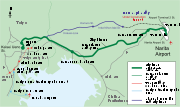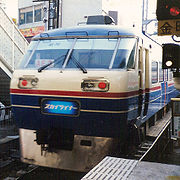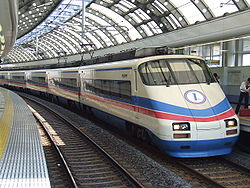
Skyliner
Encyclopedia
is a limited-express airport train service between Tokyo
and Narita Airport
. It is operated by Keisei Electric Railway
and runs on the Narita Sky Access route.
 The Skyliner service operates between Keisei Ueno Station
The Skyliner service operates between Keisei Ueno Station
and Narita Airport Station
, with stops at Nippori Station
and Airport Terminal 2 Station
.
The one-way ride between Nippori and Narita Airport takes about 36 minutes and costs ¥2,400.
The main competition for the Skyliner is JR East's Narita Express
.
 The Skyliners predecessor was the Kaiungō express service, which began operation non-stop from Keisei Ueno to Keisei Narita on May 1, 1952, 26 years before the opening of Narita Airport. Seat reservations were mandatory.
The Skyliners predecessor was the Kaiungō express service, which began operation non-stop from Keisei Ueno to Keisei Narita on May 1, 1952, 26 years before the opening of Narita Airport. Seat reservations were mandatory.
The Kaiungō Express service was operated by 1600 series trains from 1953 to 1967. Although the first trains were small, with only two cars, they had reclining seats and televisions, making them luxurious trains for their time. The trains were lengthened to three cars in 1957 (although only one of those cars was an actual Type 1600 car). In 1967, the 1600 series trains were replaced by 3150 and 3200 series trains, fitted with semi-transverse seating in order to comply with subway specifications.
In 1972, new AE series
trains began operation as the Skyliner, while the Kaiungō became the main train running during afternoons and holidays. The Kaiungō service was taken over by AE series trains on December 30, 1973, and the Skyliner became a nonstop Ueno-Narita service. Although the Skyliner's name was chosen, it wasn't announced soon enough and thus the first trains were shipped with the inscription "Express".
In the final months preceding Narita Airport's opening, there were a number of violent protests at the airport. One arson attack caused an AE series train in a yard to be put out of service on May 5, 1978.
Finally, on May 21, 1978, upon the opening of New Tokyo International Airport, the Skyliner began nonstop runs from Keisei Ueno to Narita Airport Station. At the time, Narita Airport Station was located far from the passenger terminal (at the present-day location of Higashi-Narita Station
), and passengers on the Skyliner had to get off and take a bus from the station to the airport. This inconvenience caused many passengers to use direct city-to-terminal limousine buses rather than the Skyliner.
Starting on September 1, 1979, the Skyliner began stopping at Keisei Narita Station once a day during the afternoon. This commuter-oriented service was expanded to become the Evening Liner service on December 1, 1984, and the Morning Liner was added on October 19, 1985. Nippori was added as a stop on the new commuter services, and in 1988, all Skyliners began making stops at Nippori Station.
Growing criticism of Narita ground transportation in the late 1980s led the Ministry of Transport to open up underground platforms and track initially intended for the Narita Shinkansen
(a high-speed rail link between the city and the airport that was never built) for service by regular local and express trains. On March 19, 1991, the new Narita Airport Station opened directly underneath Terminal 1. Both the Skyliner and its new competitor, JR East's Narita Express
, began service to the new station. On December 3, 1992, service began to Airport Terminal 2.
 Eight-car AE100 series
Eight-car AE100 series
trains were introduced in 1990. These trains were designed with emergency exits at each end, under the assumption that the trains would eventually be used for limited express service between Narita Airport and Haneda Airport: the Toei Asakusa Line has no emergency walkways along its sides, so it was necessary to allow evacuation from the ends of the train. Following the introduction of the AE100s, the seven six-car AE series trains were rearranged to form five eight-car trains. In June 1993, these older AE series trains were withdrawn from service.
From December 10, 2006, most Skyliner services began stopping at Keisei Funabashi Station.
EMUs. New City Liner
services using the older AE100 series trains replaced the former Skyliner on the Keisei Main Line.
The new Skyliner service allows a transfer from Central Tokyo to Narita Airport in 36 minutes, 15 minutes faster than the old route via the Keisei Main Line, making it the fastest train option connecting Narita Airport with Central Tokyo.
Tokyo
, ; officially , is one of the 47 prefectures of Japan. Tokyo is the capital of Japan, the center of the Greater Tokyo Area, and the largest metropolitan area of Japan. It is the seat of the Japanese government and the Imperial Palace, and the home of the Japanese Imperial Family...
and Narita Airport
Narita International Airport
is an international airport serving the Greater Tokyo Area of Japan. It is located east of Tokyo Station and east-southeast of Narita Station in the city of Narita, and the adjacent town of Shibayama....
. It is operated by Keisei Electric Railway
Keisei Electric Railway
The is a major private railway in Chiba and Tokyo, Japan. The name Keisei is the combination of the kanji 京 from and 成 from , which the railways main line connects. The combination uses different readings than the ones used in the city names. The railway's main line runs from Tokyo to Narita and...
and runs on the Narita Sky Access route.
Service

Keisei Ueno Station
is a train station located in Taitō, Tokyo Japan. It is the terminus of the Keisei Main Line and is in brief walking distance from JR Ueno Station .-History:* 10 October 1933 Opened as "Ueno Kōen Station"* 1 May 1953 Changed name to "Keisei Ueno Station"...
and Narita Airport Station
Narita Airport Station
is an underground train station located beneath Terminal 1 of Narita International Airport in Narita, Chiba Prefecture, Japan. The station is shared between East Japan Railway Company and Keisei Electric Railway.-Station layout:...
, with stops at Nippori Station
Nippori Station
is a major railway interchange station in Arakawa, Tokyo, Japan.The station is currently undergoing major rebuilding work to provide a connection to the adjoining Nippori-Toneri Line station...
and Airport Terminal 2 Station
Airport Terminal 2 Station
is an underground railway station located beheath Terminal 2 of Narita International Airport in Narita, Chiba, Japan. The station is linked to Higashi-Narita Station by a 500 m underground passage...
.
The one-way ride between Nippori and Narita Airport takes about 36 minutes and costs ¥2,400.
The main competition for the Skyliner is JR East's Narita Express
Narita Express
, abbreviated as N'EX, is a limited express train service operated since 1991 by East Japan Railway Company , serving Narita International Airport from various Greater Tokyo Area stations. Services are approximately half-hourly in the mornings and evenings, and hourly through the middle of the day...
.
1972-2010

The Kaiungō Express service was operated by 1600 series trains from 1953 to 1967. Although the first trains were small, with only two cars, they had reclining seats and televisions, making them luxurious trains for their time. The trains were lengthened to three cars in 1957 (although only one of those cars was an actual Type 1600 car). In 1967, the 1600 series trains were replaced by 3150 and 3200 series trains, fitted with semi-transverse seating in order to comply with subway specifications.
In 1972, new AE series
Keisei AE series (1972)
The was a DC electric multiple unit operated by Keisei Electric Railway on Skyliner limited express services to and from Narita International Airport in Japan. First delivered in 1972, the trains operated between 1973 and 1993, and were replaced by Keisei AE100 series EMUs.-See also:* Narita Express...
trains began operation as the Skyliner, while the Kaiungō became the main train running during afternoons and holidays. The Kaiungō service was taken over by AE series trains on December 30, 1973, and the Skyliner became a nonstop Ueno-Narita service. Although the Skyliner's name was chosen, it wasn't announced soon enough and thus the first trains were shipped with the inscription "Express".
In the final months preceding Narita Airport's opening, there were a number of violent protests at the airport. One arson attack caused an AE series train in a yard to be put out of service on May 5, 1978.
Finally, on May 21, 1978, upon the opening of New Tokyo International Airport, the Skyliner began nonstop runs from Keisei Ueno to Narita Airport Station. At the time, Narita Airport Station was located far from the passenger terminal (at the present-day location of Higashi-Narita Station
Higashi-Narita Station
is a railway station operated by Keisei Electric Railway in Narita, Chiba, Japan. It is 7.4 kilometers from the terminus of the Higashi-Narita Line at Keisei-Narita Station, and is located between the Terminal 2 and Terminal 1 of Narita International Airport....
), and passengers on the Skyliner had to get off and take a bus from the station to the airport. This inconvenience caused many passengers to use direct city-to-terminal limousine buses rather than the Skyliner.
Starting on September 1, 1979, the Skyliner began stopping at Keisei Narita Station once a day during the afternoon. This commuter-oriented service was expanded to become the Evening Liner service on December 1, 1984, and the Morning Liner was added on October 19, 1985. Nippori was added as a stop on the new commuter services, and in 1988, all Skyliners began making stops at Nippori Station.
Growing criticism of Narita ground transportation in the late 1980s led the Ministry of Transport to open up underground platforms and track initially intended for the Narita Shinkansen
Narita Shinkansen
The was a planned high-speed Shinkansen line proposed to connect Narita International Airport with Tokyo Station. The project was abandoned, although parts of the planned route are used by the Keisei Narita Airport Line ....
(a high-speed rail link between the city and the airport that was never built) for service by regular local and express trains. On March 19, 1991, the new Narita Airport Station opened directly underneath Terminal 1. Both the Skyliner and its new competitor, JR East's Narita Express
Narita Express
, abbreviated as N'EX, is a limited express train service operated since 1991 by East Japan Railway Company , serving Narita International Airport from various Greater Tokyo Area stations. Services are approximately half-hourly in the mornings and evenings, and hourly through the middle of the day...
, began service to the new station. On December 3, 1992, service began to Airport Terminal 2.

Keisei AE100 series
The is a DC electric multiple unit operated by Keisei Electric Railway on City Liner limited express services to and from Narita International Airport in Japan. First delivered in 1990, the trains replaced the earlier AE series EMUs operating on Skyliner services.From July 17, 2010, all AE100...
trains were introduced in 1990. These trains were designed with emergency exits at each end, under the assumption that the trains would eventually be used for limited express service between Narita Airport and Haneda Airport: the Toei Asakusa Line has no emergency walkways along its sides, so it was necessary to allow evacuation from the ends of the train. Following the introduction of the AE100s, the seven six-car AE series trains were rearranged to form five eight-car trains. In June 1993, these older AE series trains were withdrawn from service.
From December 10, 2006, most Skyliner services began stopping at Keisei Funabashi Station.
2010
From July 17, 2010, the Skyliner services were transferred from the Keisei Main Line to the Narita Sky Access route, with the introduction of new AE seriesKeisei AE series (2009)
The is a DC electric multiple unit operated by Keisei Electric Railway on Skyliner limited express services to and from Narita International Airport in Japan via the new Narita Sky Access Line...
EMUs. New City Liner
City Liner
The is a limited express airport train operated by Keisei Electric Railway between Tokyo and Narita Airport via the Keisei Main Line. The City Liner service was introduced from 17 July 2010, replacing the former Skyliner services, which were transferred to the new Narita Sky Access route from that...
services using the older AE100 series trains replaced the former Skyliner on the Keisei Main Line.
The new Skyliner service allows a transfer from Central Tokyo to Narita Airport in 36 minutes, 15 minutes faster than the old route via the Keisei Main Line, making it the fastest train option connecting Narita Airport with Central Tokyo.
See also
- City LinerCity LinerThe is a limited express airport train operated by Keisei Electric Railway between Tokyo and Narita Airport via the Keisei Main Line. The City Liner service was introduced from 17 July 2010, replacing the former Skyliner services, which were transferred to the new Narita Sky Access route from that...
- supplementary service commencing in July 2010 - Narita ExpressNarita Express, abbreviated as N'EX, is a limited express train service operated since 1991 by East Japan Railway Company , serving Narita International Airport from various Greater Tokyo Area stations. Services are approximately half-hourly in the mornings and evenings, and hourly through the middle of the day...
- competing service operated by JR East

